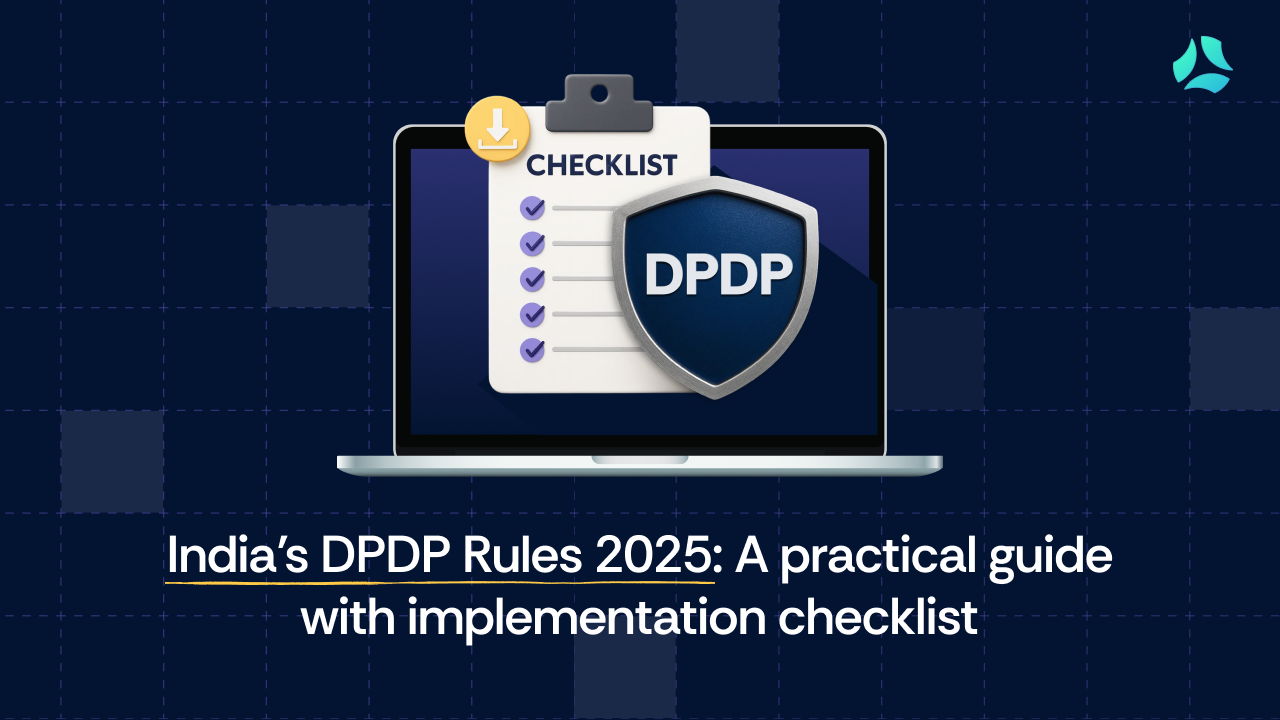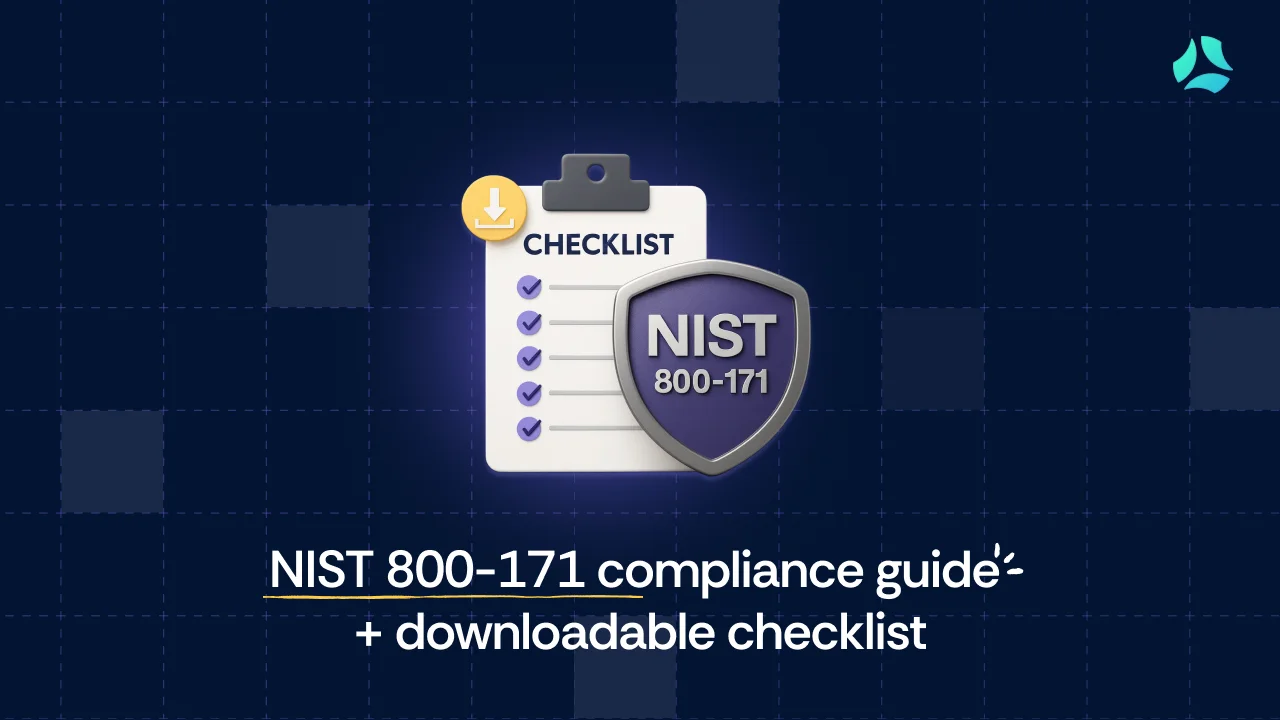Essential Guide to Navigating Compliance Audits
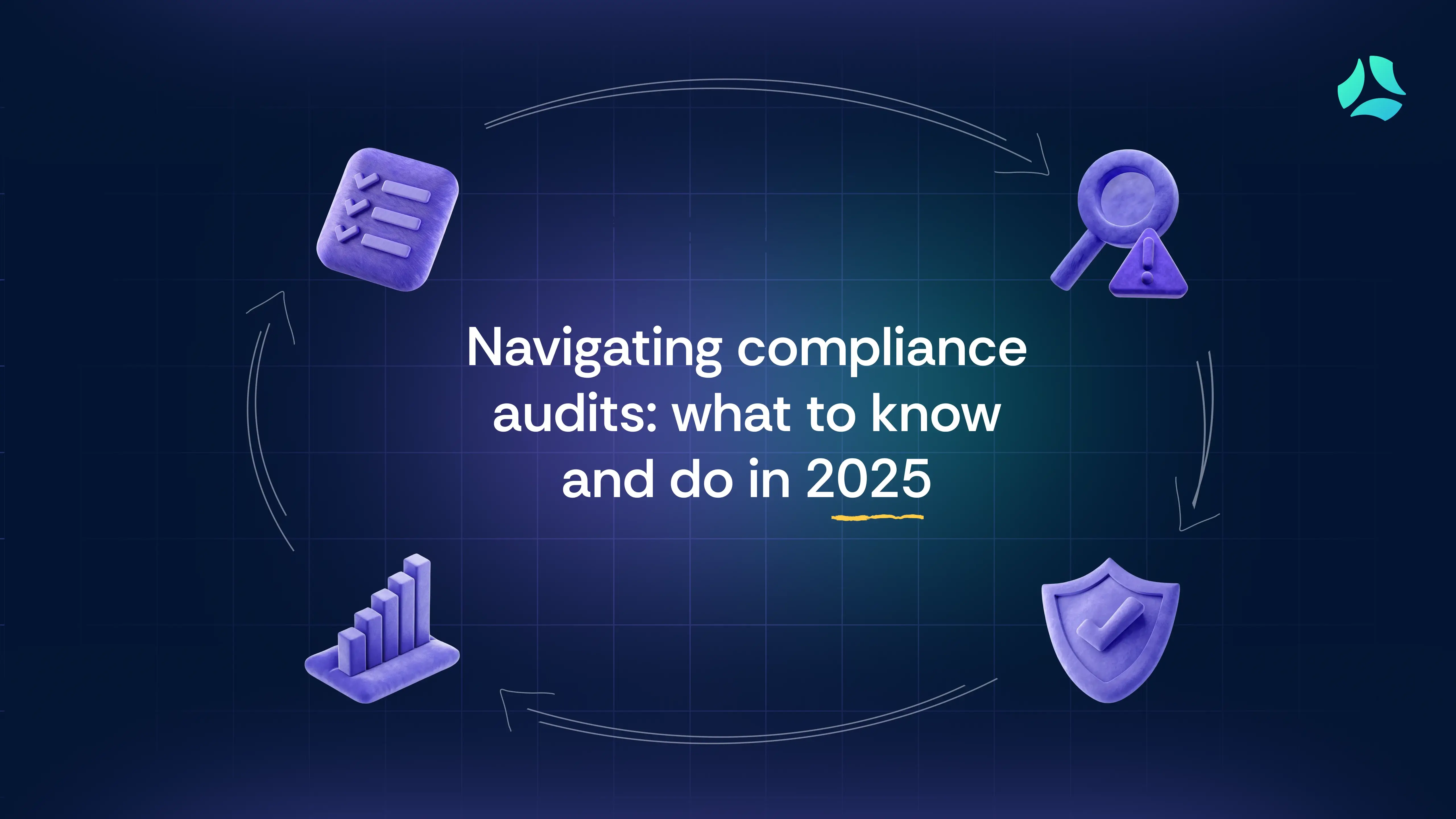
Compliance audits help businesses verify that they’re operating within the boundaries of applicable laws, regulations, internal policies, and contractual obligations. They play a critical role in identifying potential gaps in compliance, whether in financial reporting, data privacy, or vendor oversight. Audits help minimize legal, operational, and reputational risks before they escalate.
In this blog, we’ll break down what a compliance audit is, explore the different types, walk you through the process, and highlight common challenges teams face while preparing for one.
What is a Compliance Audit?
A compliance audit is a systematic review of an organization's adherence to regulatory, legal, or internal requirements. The major purpose is to identify gaps, prevent violations, ensure accountability, and build customer trust. Internal or external audits can be conducted based on requirements.
Compliance audits are usually conducted annually, though the exact frequency may vary depending on specific regulatory mandates or internal business requirements. In high-risk industries, more frequent assessments might be necessary. For internal audits, initiation and coordination generally fall under the responsibilities of compliance officers, risk managers, or internal audit teams. In contrast, for external audits, the organization’s role is more focused on preparation, documentation, and facilitating access for third-party auditors.
Example of a compliance audit
Consider a healthcare organization in the U.S. that must comply with HIPAA (Health Insurance Portability and Accountability Act). A HIPAA compliance audit might evaluate how the organization stores and secures patient records, who has access to them, and whether safeguards like data encryption are in place. All to ensure patient privacy and avoid regulatory penalties. This kind of audit helps validate adherence to legal obligations while protecting sensitive health information.
What is the purpose of a compliance audit?
The goals of a compliance audit include:
- Identifying non-compliance with laws or policies
- Preventing regulatory fines or penalties
- Ensuring internal controls are followed
- Validating operational transparency
- Enhancing stakeholder and customer trust
- Providing evidence of due diligence to regulators
Why is compliance auditing important for an organization?
Compliance audits are essential for minimizing legal exposure and reputational risk. Many organizations acknowledge that aligning with major regulations such as GDPR, HIPAA, and compliance frameworks such as SOC 2 can significantly affect operational workload. However, these efforts also enhance trust, improve internal coordination, and demonstrate a commitment to accountability. Regular audits help identify gaps, reinforce compliance readiness, and promote a culture of transparency across teams.
Types of compliance audits and frameworks
Compliance audits take various forms depending on an organization’s industry, risk exposure, and applicable laws or frameworks. Each audit type serves a distinct function, from data protection to sustainability, and is guided by relevant standards (e.g., ISO 27001), frameworks (e.g., SOC 2), or regulations (e.g., GDPR).
Below is a breakdown of key audit types and the most commonly referenced frameworks or regulations.
1. Cybersecurity and data privacy
These audits assess whether an organization has adequate controls to protect sensitive information and mitigate cyber risks. With increasing ransomware attacks and stricter data privacy laws, such audits are now central to modern compliance programs.
Insight: A report by BrightDefense shows that 80% of organizations plan to increase their cybersecurity spending in 2024, driven by the need to bolster defenses and meet evolving compliance requirements.
Commonly referenced:
- ISO/IEC 27001 – International standard for information security management systems (ISMS)
- SOC 2 – A voluntary framework that assesses security, availability, processing integrity, confidentiality, and privacy
- GDPR – Regulation governing personal data of EU residents
- HIPAA – U.S. regulation for safeguarding personal health information
- CCPA – California law regulating consumer data privacy
- PCI DSS – Standard for securing credit card transactions
2. ESG and environmental sustainability
These audits examine an organization’s environmental impact, ethical conduct, and governance practices. While ESG is a broader concept that includes social and governance aspects, environmental sustainability is a critical sub-component.
Insight: According to PwC’s 2023 Global Investor Survey, 75% of investors say that how a company manages sustainability‑related risks and opportunities is an important factor in their investment decisions.
Commonly referenced:
- ISO 14001 – Standard for environmental management systems
- EPA regulations (U.S.) – Compliance with federal environmental protection laws
- Clean air and water acts – U.S. environmental regulations
- Third-party sustainability assurance – External audits of ESG disclosures
- Supplier code of conduct audits – For evaluating vendor compliance with ESG norms
3. Financial and regulatory compliance
These audits verify the accuracy of financial reporting, assess fraud controls, and ensure adherence to tax, securities, or capital market regulations.
Commonly referenced:
- SOX (Sarbanes-Oxley Act) – U.S. regulation for financial transparency and internal controls
- IRS Guidelines – Federal tax compliance requirements
- FINRA – Oversight for securities and investment firms
- SALT – State and local tax compliance
4. Health and safety audits
These focus on compliance with occupational safety and public health standards, especially in high-risk environments.
Commonly referenced:
- OSHA – U.S. Occupational Safety and Health Administration regulations
- CMS – Regulatory body for health service providers (e.g., Medicare and Medicaid)
5. Industry-specific compliance
Many industries require tailored compliance audits based on operational risk, data sensitivity, or government oversight.
Commonly referenced:
- FISMA – Cybersecurity compliance for U.S. federal agencies
- CAN-SPAM act – Regulation for commercial electronic messaging
- NIST frameworks – Cybersecurity and risk management for defense and critical infrastructure
6. Social and labor compliance
These audits assess an organization’s adherence to fair labor practices, non-discrimination policies, and workplace ethics.
Insight: Non-compliance with labor laws can damage a company’s reputation and lead to higher employee turnover. According to G&A Partners, such violations can negatively impact employee morale and make it harder for companies to retain and attract talent.
Commonly referenced:
- HR compliance audits – Internal assessments of policies and labor law adherence
- EEOC standards – U.S. guidelines for equal employment opportunity
- Wage and hour law compliance – Audits to ensure fair compensation and overtime rules
Understanding the gap between internal audits and compliance audits
The main difference between internal and compliance audits lies in their intent, audience, and outcomes. While both contribute to a strong risk and governance posture, they serve distinct strategic objectives:
- Internal audits: Focus on improving processes, controls, and operational efficiency.
- Compliance audits: Verify whether the organization adheres to external regulatory or contractual obligations.
In short: Internal audits drive improvement. Compliance audits demonstrate conformity.
Scrut’s value across both audit types
Whether you're conducting internal audits to strengthen your risk posture or preparing for external compliance audits, Scrut unifies the entire audit lifecycle in one platform. With continuous control monitoring, evidence auto-collection, real-time gap identification, and audit-ready dashboards, Scrut helps you stay compliant and resilient, without the usual spreadsheet sprawl.
Components of a compliance audit checklist
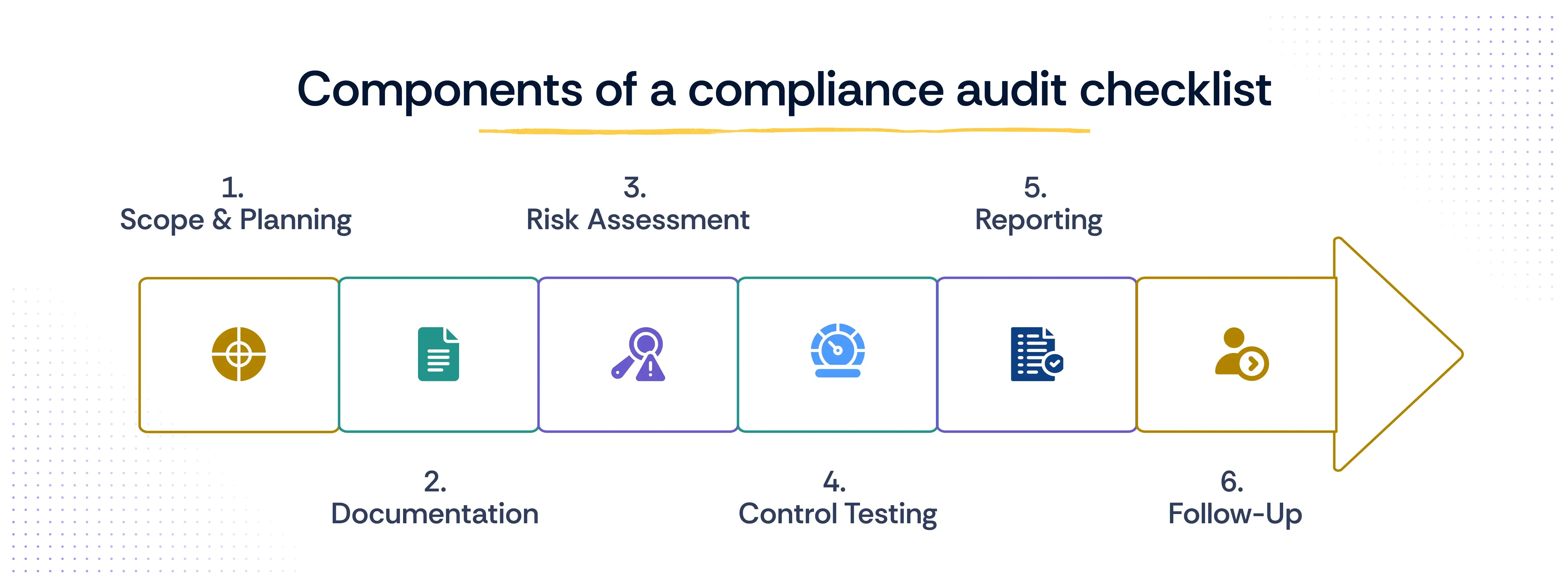
A well-structured compliance audit typically follows a phased approach. Here’s a breakdown of the key components, explained step by step:
1. Scope and planning
The audit process begins by defining clear objectives and the scope of the engagement. This involves specifying what areas, processes, or systems will be assessed and why. During this phase, organizations must also identify the applicable regulations or frameworks relevant to their business operations, such as SOC 2, ISO/IEC 27001, HIPAA, or GDPR. Equally important is assigning roles and responsibilities across the audit team and stakeholders to ensure accountability and coordination.
2. Documentation
In this phase, auditors gather internal documents such as policies, procedures, security protocols, and organizational charts. Additional documentation like access logs, change management records, and historical audit reports are also collected to establish a baseline understanding of the current control environment.
3. Risk assessment
Auditors then identify compliance-related risks that could affect the organization's ability to meet regulatory requirements. This involves mapping these risks to applicable controls and regulatory clauses. The effectiveness of existing controls is evaluated to determine if there are any gaps or areas needing remediation.
4. Control testing
Once risks and controls are mapped, auditors proceed to test key controls for their operational effectiveness. This includes conducting walkthroughs, reviewing evidence, and interviewing control owners or process stakeholders. The goal is to validate whether control activities are being executed consistently and as intended.
5. Reporting
Audit findings are compiled into a comprehensive report that includes observed control weaknesses, associated risk levels, and recommendations for corrective actions. The final audit report is typically shared with leadership, compliance officers, and sometimes external stakeholders, depending on regulatory requirements.
6. Follow-up
After the report is delivered, the audit team or compliance function tracks the progress of remediation activities. Once corrective actions are implemented, controls are retested to confirm closure. This step ensures accountability and provides assurance that compliance gaps have been properly addressed.
What Are Some Challenges in Compliance Auditing?
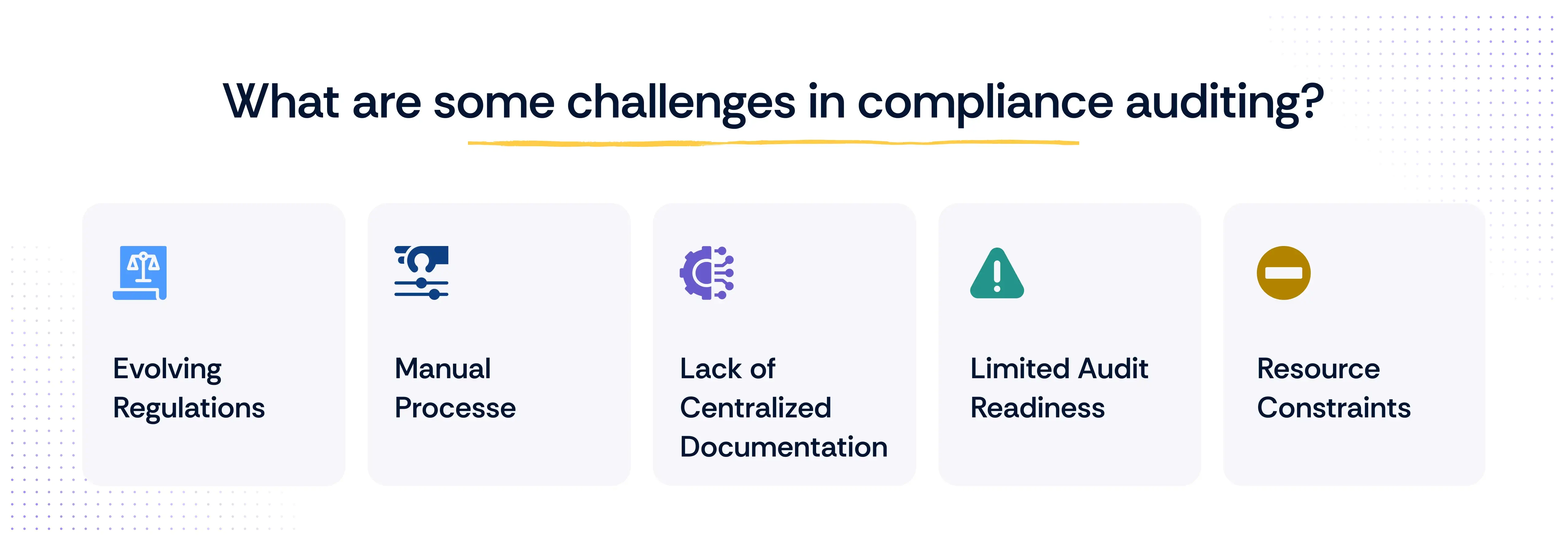
- Evolving regulations – Laws change frequently; staying updated is difficult.
- Manual processes – Relying on spreadsheets and emails introduces errors.
- Lack of centralized documentation – Information silos can delay audits.
- Limited audit readiness – Inadequate training and awareness among staff.
- Resource constraints – Lack of dedicated audit teams or tools.
What makes a compliance audit successful?
- Clear audit scope – Defined objectives and standards from the start
- Stakeholder involvement – Active participation from process owners
- Automation – Using technology to streamline evidence collection and reporting
- Timely follow-up – Swift remediation of issues uncovered
- Audit trail maintenance – Keeping a record of all decisions and findings
Are there any compliance audit services?
Yes. Many firms offer compliance audit services, from Big 4 consultancies to specialized third-party providers. These services help organizations gain an external, unbiased view of their compliance posture.
Automating compliance audits with Scrut
From chaos to control: Scrut automates every step of the audit lifecycle
Compliance teams are expected to deliver faster results with tighter resources, all while staying audit-ready year-round. That’s where Scrut comes in.
Scrut simplifies and scales your audit preparation with powerful automation and continuous monitoring. Whether you’re gearing up for a SOC 2, ISO 27001, HIPAA, or GDPR audit, Scrut helps you stay one step ahead of both internal and external requirements.
With Scrut, you can:
- Automate evidence collection across cloud services, HR systems, ticketing tools, and more with integrations that eliminate manual effort
- Map controls across multiple frameworks in one unified system to avoid duplication and reduce audit fatigue
- Monitor compliance in real-time with control health dashboards and automated alerts
- Assign ownership and track remediation directly in the platform, with accountability and timelines clearly defined
- Maintain a single source of audit truth, so you're always ready, even for surprise audits
No more spreadsheets. No last-minute scrambles. Just audit readiness, built-in.
With automated evidence collection, centralized controls, and always-on compliance dashboards, audit readiness becomes part of your daily operations. No more scrambling to gather reports or prove control effectiveness. Everything stays organized, accurate, and ready for any audit.

FAQs
How do I conduct an IT compliance audit in 2025?
Begin by identifying which frameworks apply to your business (e.g., SOC 2 for SaaS companies, HIPAA for healthcare, ISO 27001 for global security). Document your systems, processes, and controls, then test them for effectiveness. Platforms like Scrut automate much of this, from control mapping to evidence collection.
Do all organizations need to perform compliance audits?
If your organization operates in a regulated industry or handles sensitive data, compliance audits are not just recommended, they’re often required by law or contract. Even in unregulated sectors, audits are considered best practice for risk management and customer trust.
Are regulatory audits and compliance audits the same?
Not exactly. A regulatory audit is typically conducted by a government body to enforce specific laws (e.g., an IRS tax audit). A compliance audit, however, may be internal or performed by a third party to validate adherence to specific standards or contractual commitments (like SOC 2 or PCI DSS).
How often should compliance audits be conducted?
Most organizations conduct audits annually, but high-risk industries such as fintech, healthcare, and cloud infrastructure may opt for quarterly or bi-annual reviews to maintain assurance and prevent drift.
Who is qualified to perform a compliance audit?
Compliance audits can be conducted by:
- Internal audit teams
- Dedicated compliance officers
- Third-party assessors or certified firms, depending on the framework (e.g., CPA firms for SOC 2, HITRUST-approved assessors for HIPAA)
What’s the best way to prepare for a compliance audit in 2025?
Preparation starts with organized documentation, defined audit ownership, and updated policies. Leveraging a compliance automation platform like Scrut ensures all evidence, policies, and controls are centralized and audit-ready at any time.



